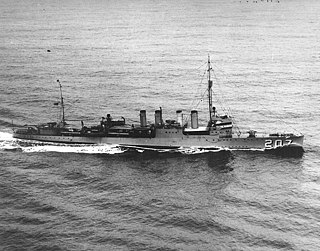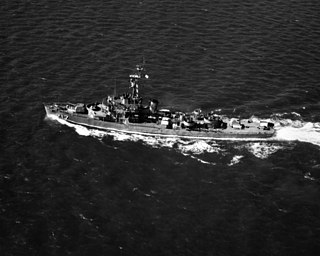
USS Mustin (DD-413) was a Sims-class destroyer of the United States Navy, the first Navy ship of that name, in honor of Captain Henry C. Mustin (1874–1923), a pioneer of naval aviation.

The third USS Farragut (DD-348) was named for Admiral David Glasgow Farragut (1801–1870). She was the lead ship of her class of destroyers in the United States Navy.

The Mahan-class destroyers of the United States Navy were a series of 18 destroyers of which the first 16 were laid down in 1934. The last two of the 18, Dunlap and Fanning, are sometimes considered a separate ship class. All 18 were commissioned in 1936 and 1937. Mahan was the lead ship, named for Rear Admiral Alfred Thayer Mahan, an influential historian and theorist on sea power.

USS Howard (DD–179), (DMS-7) was a Wickes-class destroyer in the United States Navy during World War II. She was named for Charles W. Howard, who was killed in the American Civil War aboard USS New Ironsides.

USS Manley (DD-74/AG-28/APD-1), a Caldwell-class destroyer, served in the United States Navy. She was the second Navy ship named for Captain John Manley (c.1733–1793).

USS Southard (DD-207/DMS-10) was a Clemson-class destroyer in the United States Navy during World War II. She was the second Navy ship named for Secretary of the Navy Samuel L. Southard (1787–1842).

USS Acree (DE-167) was a Cannon-class destroyer escort in service the United States Navy from 1943 to 1946. She was scrapped in 1973.

The second USS Selfridge (DD-357) was a Porter-class destroyer in the United States Navy. She was named for Rear Admiral Thomas O. Selfridge (1804–1902) and his son, Thomas O. Selfridge, Jr. (1836–1924).

USS Drayton (DD-366) was a Mahan-class destroyer in the United States Navy before and during World War II. She was the second ship named for Captain Percival Drayton, a career naval officer who served during the American Civil War.

The fourth USS Flusser (DD-368) was a Mahan-class destroyer in the United States Navy before and during World War II. She was named for Charles W. Flusser.

The second USS Conyngham (DD-371) was a Mahan-class destroyer used in the United States Navy before and during World War II. She was named after Gustavus Conyngham.
USS PC-1136 was a PC-461-class submarine chaser built for the United States Navy during World War II. Shortly after the end of the war, she was renamed USS PCC-1136 when she was reclassified as a combat communications control ship. In 1956, she was renamed Galena (PC-1136), becoming the third U.S. Navy vessel so named, but never saw active service under that name.

USS Coolbaugh (DE-217) was a Buckley-class destroyer escort in service with the United States Navy from 1943 to 1960. She was scrapped in 1973.
USS Skylark (AM-63) was an Auk-class minesweeper built for the United States Navy during World War II. She earned three battle stars during World War II. Skylark was mined and sunk off Okinawa in April 1945. She was struck from the Naval Vessel Register the same day.

USS LeHardy (DE-20) was an Evarts-class destroyer escort constructed for the United States Navy during World War II. It was promptly sent off into the Pacific Ocean to protect convoys and other ships from Japanese submarines and fighter aircraft. At the end of the war, she had the honor of proceeding to Wake Island, as the Japanese commander surrendered, and raising a flagpole to fly the American flag once again.

USS Stadtfeld (DE-29) was an Evarts-class destroyer escort constructed for the United States Navy during World War II. It was promptly sent off into the Pacific Ocean to protect convoys and other ships from Japanese submarines and fighter aircraft. By the end of the war, when she returned to the United States, she was awarded four battle stars.

USS McConnell (DE-163) was a Cannon-class destroyer escort built for the United States Navy during World War II. She served in the Pacific Ocean and provided escort service against submarine and air attack for Navy vessels and convoys. She was awarded three battle stars.

USS Osterhaus (DE-164) was a Cannon-class destroyer escort in service with the United States Navy from 1943 to 1946. She was scrapped in 1974.

USS Maurice J. Manuel (DE-351) was a John C. Butler-class destroyer escort acquired by the U.S. Navy during World War II. The primary purpose of the destroyer escort was to escort and protect ships in convoy, in addition to other tasks as assigned, such as patrol or radar picket.

USS Loeser was a Buckley-class destroyer escort of the United States Navy, named in honor of Lieutenant Commander Arthur E. Loeser (1903–1942).


















